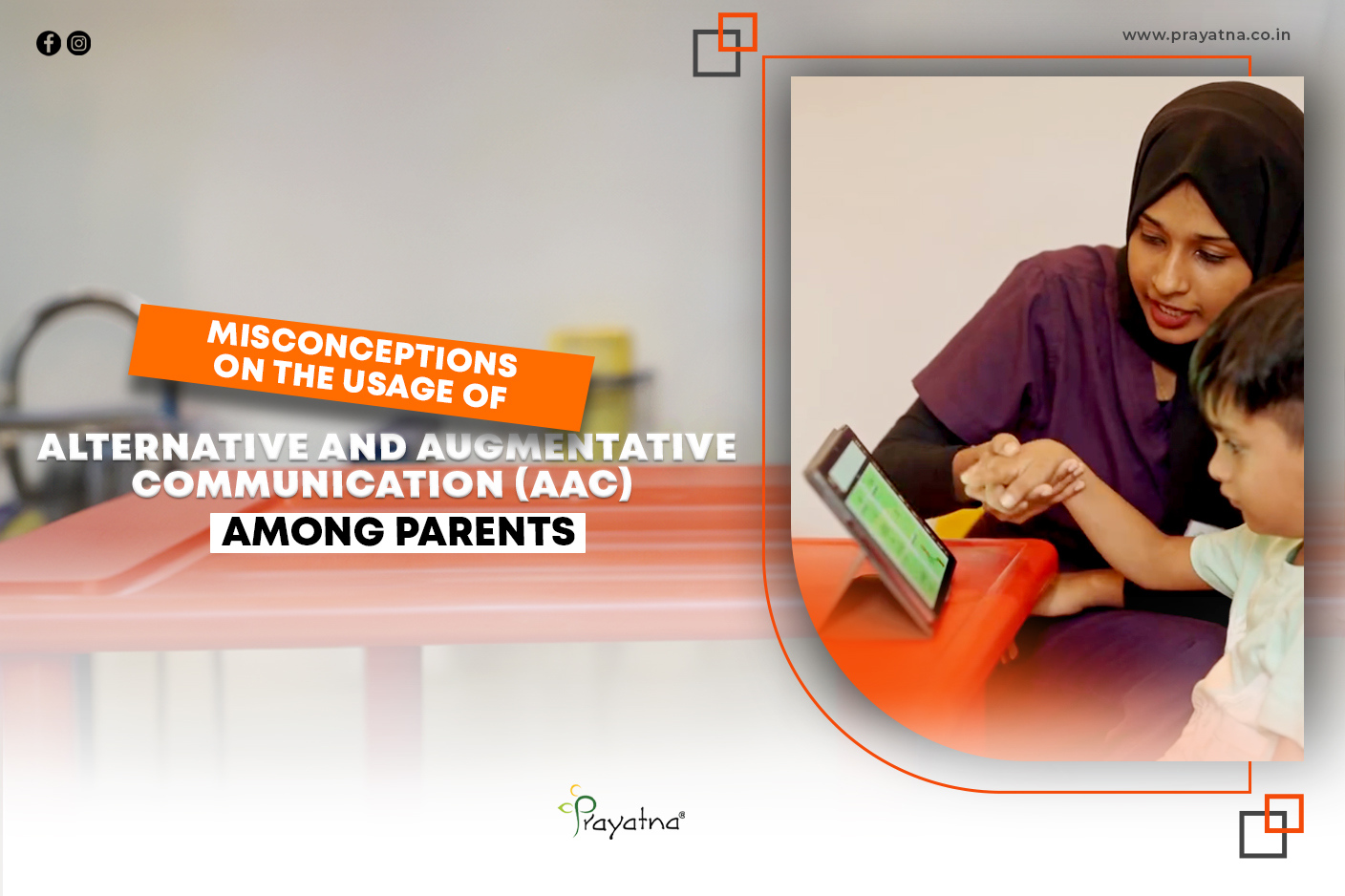
Written By
Ms. Sneha Rachel Jacob
Speech Language Pathologist
Misconceptions on the usage of Alternative and Augmentative communication among parents
Alternative and augmentative communication (AAC) is any form of nonverbal communication that is used to enhance speech. AAC plays a vital role in the lives of people with speech and language impairments, providing them with tools to communicate effectively. It can be used among the pediatric population as well as adult populations.
How Early Can AAC Interventions Begin In Children?
Communication begins at birth, with interaction opportunities and the earliest behaviors of children, regardless of the communicative modality. All children, initially communicate through spontaneous behaviors in response to their internal state or environment and the corresponding interpretation of those behaviors by someone in their environment. Although not all children at this basic level of communication produce the same types of signals, such as facial grimaces, cries and other vocal signals, children in alert states will react to certain stimuli in their surroundings. When a child’s earliest communication behaviors are difficult to interpret, the child’s need for AAC intervention begins.
A large amount of research studies shows that augmentative and alternative communication (AAC) intervention facilitated speech production and language acquisition better than spoken language alone. Recent research in this area showed effectiveness not only in cognitive and linguistic development, but also in improving functional and intelligible speech.
However, AAC is often misunderstood due to persistent myths and misconceptions that surround its use.
When people hear about Alternative Augmentative Communication (AAC), their reactions often reflect misconceptions rooted in outdated thinking or lack of exposure. AAC, which encompasses everything from picture boards to sophisticated speech-generating devices, is a lifeline for many individuals. But to fully appreciate its potential, we need to clear up some common myths that can cloud our understanding.
Some of the common misconceptions include but are not limited to the following:
Myth 1: Augmented communication will hinder/stop further speech development
Published literature and clinical experience supports the assertion that AAC does not interfere with a child’s natural ability to develop verbal communication. Communication rates for people who use AAC are approximately 15-20 times slower than communication rates for people who use typical speech (Beukelman & Mirenda, 2013). Children tend to use the quickest, most effective, and most accessible means available to communicate their wants and needs. Available research indicates that AAC may actually facilitate verbal communication by increasing interaction, language skills, reducing frustration and/or providing a voice output model for speech.
Because AAC includes all communication methods, intervention also addresses improving functional verbal skills. Modeling of AAC strategies typically includes providing a verbal model for the message, such as saying ‘more’ while reinforcing a child’s spontaneous signal to continue an activity
Myth 2: My child uses words, so they don’t need AAC
Truth: Just because a child speaks doesn’t mean that their speech is understood.
The goal of AAC is to augment, or increase communication. “If someone talks but not clearly, frustration can increase. The speaker as well as the listener gets frustrated. When frustration increases, there is an interruption in connection and interaction.
When children use AAC, they are able to communicate without anything hindering their message and they feel empowered to continue with communication attempts. It is also important to note that AAC can be used as an “add-on” or support, especially when a child is still learning to understand language, like using the correct grammar forms or verb tenses for example.
Myth 3: AAC is a Last Resort
According to Pennington & Noble, 2010, some parents report that they would rather wait and see if communication skills develop, or express worries that AAC will impede their children’s speech development. In reality, AAC can be introduced early to complement other forms of communication. High-tech devices that have a voice output when activated give children a model of vocal approximations along with a visual stimuli at the same time.
Myth 4: AAC is Only for Non-Verbal Individuals
AAC is not exclusively for those who cannot speak. It can be beneficial for anyone with difficulty communicating, whether due to a physical, cognitive, or developmental condition. AAC tools can support various communication needs, from expressing complex ideas to overcoming temporary speech challenges.
Myth 5: AAC Replaces All Other Forms of Communication
Some people fear that once AAC is introduced, it will overshadow all other forms of communication, including natural speech, gestures, or facial expressions. However, AAC is not meant to replace but to supplement communication. It works alongside other modes, enhancing the user’s ability to express themselves in various contexts. For many, AAC acts as a bridge, connecting different forms of communication rather than isolating them.
Myth 6: AAC Requires Expensive, High-Tech Devices
While there are high-tech AAC options available, like speech-generating devices, AAC doesn’t have to be expensive or technology-driven. Low-tech options like picture boards, communication books, and even simple sign language can be incredibly effective. These options are accessible, easy to use, and can be a starting point for many.
Myth 7: AAC Use Means Giving Up on Traditional Speech Therapy
There’s a misconception that using AAC means abandoning traditional speech therapy. In reality, AAC is often used in conjunction with speech therapy. It provides a means of communication that can enhance and accelerate the progress made in speech therapy. For many users, AAC is a temporary support that helps them transition to more natural speech, while for others, it remains a permanent and effective communication method.
By dispelling these myths and understanding the true value of AAC, we can encourage its adoption and use in ways that empower individuals, foster independence, and promote inclusion. Let’s move beyond misconceptions and recognize AAC as a key to unlocking communication potential for all.

